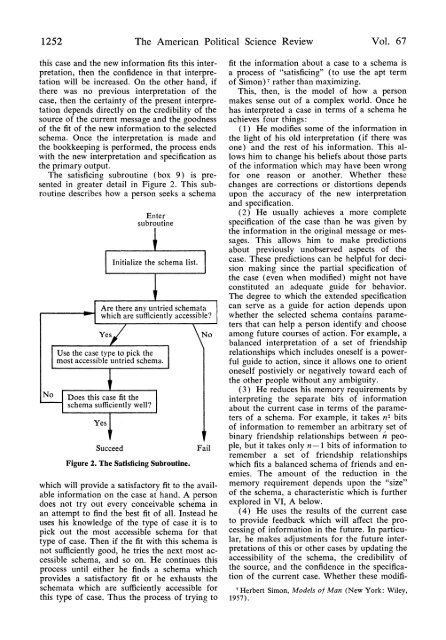Schema Theory: An Information Processing Model of Perception and ...
Schema Theory: An Information Processing Model of Perception and ...
Schema Theory: An Information Processing Model of Perception and ...
Create successful ePaper yourself
Turn your PDF publications into a flip-book with our unique Google optimized e-Paper software.
1252 The American Political Science Review Vol. 67<br />
this case <strong>and</strong> the new information fits this inter-<br />
pretation, then the confidence in that interpre-<br />
tation will be increased. On the other h<strong>and</strong>, if<br />
there was no previous interpretation <strong>of</strong> the<br />
case, then the certainty <strong>of</strong> the present interpre-<br />
tation depends directly on the credibility <strong>of</strong> the<br />
source <strong>of</strong> the current message <strong>and</strong> the goodness<br />
<strong>of</strong> the fit <strong>of</strong> the new information to the selected<br />
schema. Once the interpretation is made <strong>and</strong><br />
the bookkeeping is performed, the process ends<br />
with the new interpretation <strong>and</strong> specification as<br />
the primary output.<br />
The satisficing subroutine (box 9) is pre-<br />
sented in greater detail in Figure 2. This sub-<br />
routine describes how a person seeks a schema<br />
Enter<br />
subroutine<br />
Iniialize the schema list.|<br />
Are there any untried schemata<br />
which are sufficiently accessible?<br />
Yes No<br />
Use the case type to pick the<br />
most accessible untried schema.<br />
No Does this case fit the<br />
schema sufficiently well?<br />
Yes<br />
Succeed Fail<br />
Figure 2. The Satisficing Subroutine.<br />
which will provide a satisfactory fit to the avail-<br />
able information on the case at h<strong>and</strong>. A person<br />
does not try out every conceivable schema in<br />
an attempt to find the best fit <strong>of</strong> all. Instead he<br />
uses his knowledge <strong>of</strong> the type <strong>of</strong> case it is to<br />
pick out the most accessible schema for that<br />
type <strong>of</strong> case. Then if the fit with this schema is<br />
not sufficiently good, he tries the next most ac-<br />
cessible schema, <strong>and</strong> so on. He continues this<br />
process until either he finds a schema which<br />
provides a satisfactory fit or he exhausts the<br />
schemata which are sufficiently accessible for<br />
this type <strong>of</strong> case. Thus the process <strong>of</strong> trying to<br />
fit the information about a case to a schema is<br />
a process <strong>of</strong> "satisficing" (to use the apt term<br />
<strong>of</strong> Simon) 7 rather than maximizing.<br />
This, then, is the model <strong>of</strong> how a person<br />
makes sense out <strong>of</strong> a complex world. Once he<br />
has interpreted a case in terms <strong>of</strong> a schema he<br />
achieves four things:<br />
(1) He modifies some <strong>of</strong> the information in<br />
the light <strong>of</strong> his old interpretation (if there was<br />
one) <strong>and</strong> the rest <strong>of</strong> his information. This al-<br />
lows him to change his beliefs about those parts<br />
<strong>of</strong> the information which may have been wrong<br />
for one reason or another. Whether these<br />
changes are corrections or distortions depends<br />
upon the accuracy <strong>of</strong> the new interpretation<br />
<strong>and</strong> specification.<br />
(2) He usually achieves a more complete<br />
specification <strong>of</strong> the case than he was given by<br />
the information in the original message or mes-<br />
sages. This allows him to make predictions<br />
about previously unobserved aspects <strong>of</strong> the<br />
case. These predictions can be helpful for deci-<br />
sion making since the partial specification <strong>of</strong><br />
the case (even when modified) might not have<br />
constituted an adequate guide for behavior.<br />
The degree to which the extended specification<br />
can serve as a guide for action depends upon<br />
whether the selected schema contains parame-<br />
ters that can help a person identify <strong>and</strong> choose<br />
among future courses <strong>of</strong> action. For example, a<br />
balanced interpretation <strong>of</strong> a set <strong>of</strong> friendship<br />
relationships which includes oneself is a power-<br />
ful guide to action, since it allows one to orient<br />
oneself postiviely or negatively toward each <strong>of</strong><br />
the other people without any ambiguity.<br />
(3) He reduces his memory requirements by<br />
interpreting the separate bits <strong>of</strong> information<br />
about the current case in terms <strong>of</strong> the parame-<br />
ters <strong>of</strong> a schema. For example, it takes n2 bits<br />
<strong>of</strong> information to remember an arbitrary set <strong>of</strong><br />
binary friendship relationships between n' peo-<br />
ple, but it takes only n-1 bits <strong>of</strong> information to<br />
remember a set <strong>of</strong> friendship relationships<br />
which fits a balanced schema <strong>of</strong> friends <strong>and</strong> en-<br />
emies. The amount <strong>of</strong> the reduction in the<br />
memory requirement depends upon the "size"<br />
<strong>of</strong> the schema, a characteristic which is further<br />
explored in VI, A below.<br />
(4) He uses the results <strong>of</strong> the current case<br />
to provide feedback which will affect the pro-<br />
cessing <strong>of</strong> information in the future. In particu-<br />
lar, he makes adjustments for the future inter-<br />
pretations <strong>of</strong> this or other cases by updating the<br />
accessibility <strong>of</strong> the schema, the credibility <strong>of</strong><br />
the source, <strong>and</strong> the confidence in the specifica-<br />
tion <strong>of</strong> the current case. Whether these modifi-<br />
7'Herbert Simon, <strong>Model</strong>s <strong>of</strong> Man (New York: Wiley,<br />
1957).


